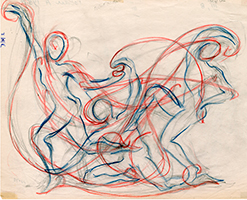 In the preface to his book, Choreutics, Laban links his modern studies of movement to Pythagorean mathematics, notably musical scales and the “harmonic relations” of geometrical forms such as the right triangle and circle. Laban appears to have coined the term Choreutics from two Greek root words: “khoreia” (dancing in unison) and “eu” (beautiful, harmonious).
In the preface to his book, Choreutics, Laban links his modern studies of movement to Pythagorean mathematics, notably musical scales and the “harmonic relations” of geometrical forms such as the right triangle and circle. Laban appears to have coined the term Choreutics from two Greek root words: “khoreia” (dancing in unison) and “eu” (beautiful, harmonious).
Laban goes on to define Choreutics as “the practical study of harmonised movement.” Latter day colleagues of Laban’s, such as Valerie Preston-Dunlop and Vera Maletic, have delineated Choreutics respectively as the “spatial organization for dance” and “the theory and practice of ordering movement in space.”
Choreutics, then, deals with the spatial aspects of movement, with its organization and order. As an analytical study, Choreutics delineates the natural paths that the limbs of the body trace on the space around the body, paths that Laban calls “trace-forms.” However, in keeping with its Pythagorean roots, Laban’s Choreutic theory goes beyond mere description of natural movement to designate harmonic spatial sequences analogous to musical scales.
In creating these harmonic designs, Laban utilizes his artistic understanding of human anatomy, proportion, and range of motion. Moreover, he draws on his Art Nouveau background to generate spatial patterns that are highly symmetrical.
Art Nouveau designers stylized the curves of natural forms such as butterflies, flowers, and leaves to create beautiful two-dimensional patterns. Laban’s space harmony scales are similar. Laban has taken the curves of natural movements and geometricized them, creating “harmonic” three-dimensional patterns.
Space plays a role in movement harmony. But so does time. And this is where Laban’s Eukinetic theories come into play. I address Eukinetics in my next blog.
